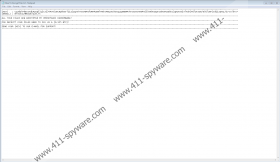Minotaur Ransomware Removal Guide
Minotaur Ransomware is a malicious infection that may turn your world upside down if it ever slithers onto your computer. We say so because this computer threat is one of those harmful infections that enter computers and lock those users’ personal files they manage to find on affected computers. These files may include important documents, slides, music, videos, and all pictures. Malicious software developers program these infections in such a way so that it would be easier to obtain money from them. You are probably thinking about sending money to cyber criminals that have released Minotaur Ransomware if you have already encountered this infection, but our piece of advice for you would be completely different – to keep the money and delete the ransomware infection fully instead. It is one of the simplest ransomware infections recently analyzed by malware researchers working at 411-spyware.com. It does not make any modifications on the affected computer except for locking users’ personal files, so you will remove it from your system without difficulty. Unfortunately, it does not mean that your files will be unlocked. There are no guarantees that they will be unlocked for you even if you pay a ransom the threat demands.
Those ransomware infections that encrypt files on affected computers use different filename extensions. If Minotaur Ransomware is the crypto-threat you encounter, all encrypted files on your computer will receive the .lock extension. For example, your original picture mypicture.jpg will be changed to mypicture.jpg.lock. Needless to say, not only pictures will be affected by this threat. As mentioned, it will lock almost everything, from your documents to your videos. Luckily, this computer threat does not try to ruin any system files. Once the file encryption takes place on the affected computer, Minotaur Ransomware drops a ransom note (How To Decrypt Files.txt) to all the folders containing encrypted files and some other root folders. The ransom note dropped contains a key, an email address, and a short message. Victims are told that their all files have been encrypted by Minotaur Ransomware, and now they need to pay 0.125 BTC (~ 507 USD at today’s price) to the ransomware author. To get more information on the payment, users have to send the key indicated in the ransom note to the email that belongs to ransomware developers – minotaur@420blaze.it. Do not waste your time sending emails to cyber criminals – there are no guarantees that paying the ransom will have the desirable effect, i.e. your files will be unlocked, so it would be best not to send a cent to crooks but delete the ransomware infection instead.
We do not have much evidence that would confirm that Minotaur Ransomware is distributed one way or another because it is not one of those prevalent threats; however, specialists suspect that ordinary distribution methods should be used to promote this infection too. For example, the chances are high that it will be sent to users whose emails cyber criminals manage to obtain as an attachment. It is quite a common way to distribute malware, so you should carefully inspect all attachments before opening them. Needless to say, attachments spam emails hold should be ignored completely. Also, it would be best not to download any applications from suspicious websites and avoid pirated software to prevent serious malware from entering the system. Last but not least, every user who browses the web every day has to install a reputable security application on the system. If it ever happens that you do not recognize malware or click on the fake malicious Download button, you will be warned about that immediately and the tool will take action in order not to let malware to enter the system.
You do not need to be an expert to be able to remove Minotaur Ransomware from your system manually – there is only one major file you have to remove to erase this threat. This file is a recently downloaded and opened malicious file, e.g. email attachment. Of course, you will also have to eliminate ransom notes from all affected directories, but this file is a simple .txt file that will not launch the ransomware infection on your PC again, so there is no rush to remove it – take your time.
Delete Minotaur Ransomware
- Press Win+E.
- Insert the folder you keep your downloads, e.g. %USERPROFILE%\Downloads in the URL bar at the top and press Enter.
- Delete recently downloaded suspicious files.
- Locate How To Decrypt Files.txt in affected folders.
- Delete it from all the places.
- Empty Trash.
Minotaur Ransomware Screenshots:


